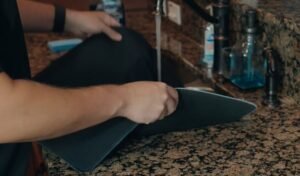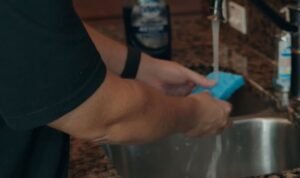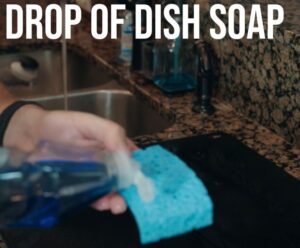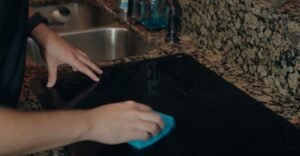Are you tired of using a dirty mouse pad that hinders your gaming experience? Look no further! In this comprehensive guide, we’ll walk you through the step-by-step process of cleaning your mouse pad effectively, ensuring it looks and feels as good as new. With just a few simple household items, you can say goodbye to dirt and grime, and hello to smooth and precise mouse movements.
- Prepare Your Supplies
To begin, gather the following items:
- Clean sponge
- Regular dish soap
- Sink or basin
Preparing Your Mouse Pad for Cleaning
The first step in the cleaning process is to thoroughly wet your mouse pad. Using your sink or basin, evenly distribute water across the surface of the pad. This pre-soaking step helps loosen dirt and grime, making it easier to remove during the scrubbing process.

- Soak Your Sponge
Next, wet your sponge with cold to room temperature water. Be sure not to use water that is too hot, as it could potentially damage the mouse pad. Add a small drop of dish soap to the sponge, ensuring it lathers up nicely. Any brand of dish soap will suffice, as long as it’s not too harsh.


Scrubbing Away Dirt and Grime
Now it’s time to roll up your sleeves and get scrubbing! Gently scrub the entire surface of the mouse pad, focusing on areas with visible dirt and stains. While this method is safe for most mouse pads, it’s particularly beneficial for high-end pads, as it allows for greater control over the cleaning process.

Why Hand Scrubbing is Preferred?
Using a sponge allows for a gentle yet effective cleaning process, ensuring that the pad’s fibers remain intact. Unlike harsher methods like washing machines or dishwashers, hand scrubbing minimizes the risk of damage and ensures a thorough clean.
Rinse and Repeat
Once you’ve scrubbed away the dirt and grime, it’s time to rinse off the soap suds. Use cool water to thoroughly rinse the mouse pad, ensuring that all traces of soap are removed. Pay extra attention to corners and edges, where soap residue may linger.
Choosing the Right Washing Location
While a sink is ideal for cleaning mouse pads, a bathtub can also be used if you have one. However, be sure to clean the bathtub beforehand to avoid transferring dirt and grime onto your freshly cleaned mouse pad.
Drying Your Mouse Pad
After rinsing, gently squeeze out any excess water from the mouse pad. To aid in the drying process, lay the pad flat on a clean towel and blot away remaining moisture. Finally, allow the mouse pad to air dry overnight, ensuring it’s completely dry before its next use.
The Importance of Proper Drying
Proper drying is essential to prevent mold and mildew from forming on your mouse pad. By allowing it to air dry completely, you’ll ensure it remains hygienic and ready for use.
Conclusion
And there you have it! By following these simple steps, you can keep your mouse pad looking and feeling brand new for years to come. Whether you’re a casual gamer or a seasoned pro, a clean mouse pad is essential for optimal gaming performance.
Frequently Asked Questions (FAQs) About Cleaning Mouse Pads
Q1: Can I use any type of dish soap to clean my mouse pad?
A1: Yes, you can use any regular dish soap for cleaning your mouse pad. Just ensure that it’s not too harsh to avoid damaging the pad’s surface.
Q2: How often should I clean my mouse pad?
A2: It’s recommended to clean your mouse pad regularly, especially if you notice dirt or grime buildup. For heavy users, cleaning once every few weeks is ideal, while casual users can clean less frequently.
Q3: Can I machine wash my mouse pad?
A3: While some mouse pads are machine washable, hand washing is generally recommended to prevent damage to the pad’s surface and ensure a thorough clean.
Q4: Will cleaning my mouse pad affect its performance?
A4: Proper cleaning can actually improve your mouse pad’s performance by removing dirt and grime that may cause friction or interference with mouse movements.
Q5: How long does it take for a mouse pad to air dry?
A5: The drying time can vary depending on factors such as humidity and airflow. Generally, allowing the mouse pad to air dry overnight should ensure it’s completely dry and ready for use the next day.
Q6: Can I use a hairdryer to speed up the drying process?
A6: While using a hairdryer may seem convenient, it’s not recommended as the heat can potentially damage the mouse pad’s surface. It’s best to allow it to air dry naturally.
Q7: Will cleaning my mouse pad remove stains?
A7: Yes, cleaning your mouse pad using the method outlined in the article can effectively remove stains and restore its appearance.
Q8: Can I clean other types of mouse pads using this method?
A8: Yes, this cleaning method is suitable for most types of mouse pads, including cloth, rubber, and hybrid pads. However, always check the manufacturer’s recommendations for specific care instructions.
Q9: Is it necessary to clean my mouse pad if I use a mouse with a built-in sensor?
A9: Yes, even if your mouse has a built-in sensor, dirt and grime on the mouse pad can still affect its performance. Regular cleaning is essential for optimal gaming or work experience.
Q10: How do I know if my mouse pad needs cleaning?
A10: Signs that your mouse pad needs cleaning include visible dirt or stains, a rough or sticky surface, or inconsistent mouse movements. If you notice any of these issues, it’s time to give your mouse pad a thorough clean.
